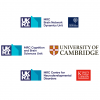Post-stroke upper limb recovery is correlated with dynamic resting-state network connectivity.
Motor recovery is still limited for people with stroke especially those with greater functional impairments. In order to improve outcome, we need to understand more about the mechanisms underpinning recovery. Task-unbiased, blood flow-independent post-stroke neural activity can be acquired from resting brain electrophysiological recordings and offers substantial promise to investigate physiological mechanisms, but behaviourally relevant features of resting-state sensorimotor network dynamics have not yet been identified. Thirty-seven people with subcortical ischaemic stroke and unilateral hand paresis of any degree were longitudinally evaluated at 3 weeks (early subacute) and 12 weeks (late subacute) after stroke. Resting-state magnetoencephalography and clinical scores of motor function were recorded and compared with matched controls. Magnetoencephalography data were decomposed using a data-driven hidden Markov model into 10 time-varying resting-state networks. People with stroke showed statistically significantly improved Action Research Arm Test and Fugl-Meyer upper extremity scores between 3 weeks and 12 weeks after stroke (both < 0.001). Hidden Markov model analysis revealed a primarily alpha-band ipsilesional resting-state sensorimotor network which had a significantly increased life-time (the average time elapsed between entering and exiting the network) and fractional occupancy (the occupied percentage among all networks) at 3 weeks after stroke when compared with controls. The life-time of the ipsilesional resting-state sensorimotor network positively correlated with concurrent motor scores in people with stroke who had not fully recovered. Specifically, this relationship was observed only in ipsilesional rather in contralesional sensorimotor network, default mode network or visual network. The ipsilesional sensorimotor network metrics were not significantly different from controls at 12 weeks after stroke. The increased recruitment of alpha-band ipsilesional resting-state sensorimotor network at subacute stroke served as functionally correlated biomarkers exclusively in people with stroke with not fully recovered hand paresis, plausibly reflecting functional motor recovery processes.
2024. Brain Commun, 6(1):fcae011.
2023. PLoS Biol, 21(6)e3002140.
